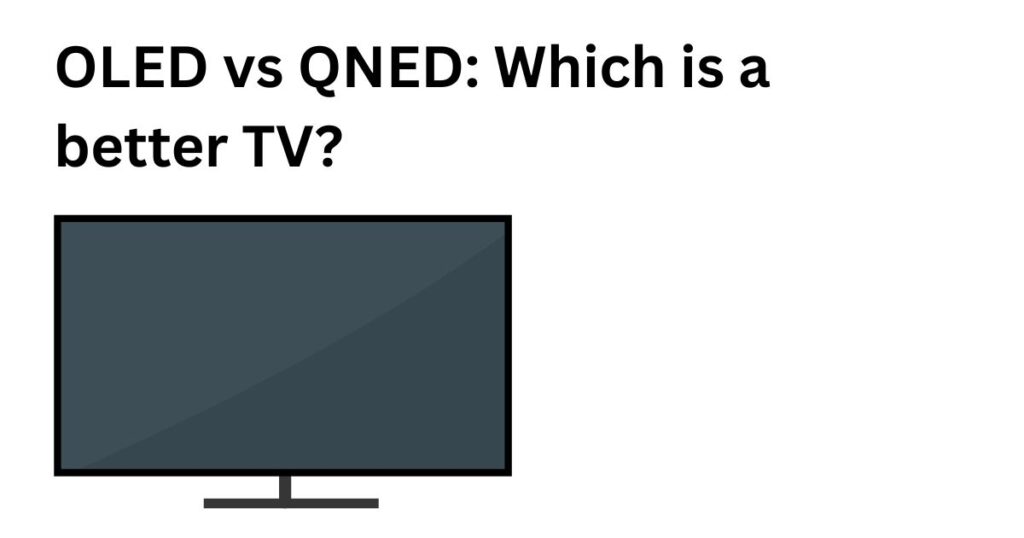OLED vs QNED: Which is a better TV?

OLED
OLED stands for Organic Light-Emitting Diode. An OLED TV has individually controlled self-emissive pixels.
Each of these pixels can be turned on or off independently depending on the requirement of the scene. Thus, when a pixel is off, it emits no light, resulting in perfect contrast.
Because every pixel is self-emissive and individually controlled, OLED displays deliver very accurate colors and maintain their quality even when you view it from the corners.
The ability of these pixels to switch on and off instantly also leads to ultra-fast response times, making OLEDs ideal for fast-paced action scenes.
They also deliver a superb gaming experience where every fraction of second counts.
QNED
QNED is an LG’s display technology which stands for Quantum Nano-Emitting Diode. It is a type of LCD TV which makes the use of mini LED backlight combined with Nanocells and a layer of quantum dots.
As claimed by LG, a QNED TV uses approximately 30,000 mini-LEDs and close to 2,500 dimming zones. Therefore, compared to a normal LED LCD TV, the contrast is far superior on a QNED TV owing to a large number of dimming zones which can control the screen brightness more precisely.
The Nanocell technology along with the quantum dots helps in displaying purer colors on the screen.
Additionally, the mini-LED backlighting can reach impressive levels of brightness, ensuring the screen remains visible and vibrant, even in bright rooms or with sunlight coming through the window.
This makes it ideal for watching content in well-lit environments, with no issue from glare or reflections.
OLED vs QNED: Key Differences
When you view an OLED TV in a store, you may not realise it’s true potential. The reason being that the lighting in a store is generally too much.
So, whether you are viewing an OLED TV or a QNED TV will not make much difference. It might be possible that the QNED looks better in the store owing to its typically higher brightness levels.
However, once you bring an OLED TV home, draw the curtains, and dim the lights, the experience is entirely different and truly stunning. The picture quality will blow you away.
No LCD TV can match the deep, perfect blacks of an OLED because each pixel can completely turn off when not in use. This gives OLED displays an exceptional contrast ratio.
Another major advantage is the consistent picture quality from every viewing angle. No matter where you sit in the room, the image remains just as good.
There’s no blooming around bright objects. The whites appear brilliantly bright while the blacks stay completely dark. This level of picture perfection is something only OLED technology can deliver, no other TV type comes close.
On the other hand, being an LCD TV, the colors may look somewhat washed out on a QNED TV, blacks are not like what you get on OLEDs.
You can still see some light peeping out through the screen in dark scenes also, as the LED backlight is always on. Thus, the screen may appear slightly greyish instead of being completely black.
Even with advanced Mini LED local dimming, QNED TVs still can’t achieve the perfect blacks that only an OLED panel can deliver.
However, the black levels on a QNED TV are significantly better than those on regular LED LCD TVs with not-so-good local dimming, making QNED a solid step up from standard LED displays.
If you usually watch TV in a bright room, a QNED TV could actually be a more practical choice because of its higher peak brightness compared to OLEDs, especially older ones.
But here’s the catch: modern OLED TVs have made great strides in brightness too, thanks to technologies like LG’s MLA (Micro Lens Array) and Samsung’s QD-OLED panels.
Moreover, the OLEDs handle the reflections very well, so glare in a brightly lit room is much less of an issue than before.
OLED vs QNED: The Verdict
After comparing OLED and QNED technologies, it’s clear that modern OLED TVs offer the best overall experience.
With their ability to produce true blacks, ultra-fast response times, widest viewing angles, wide color gamut, and excellent reflection handling, OLEDs deliver exceptional picture quality that is hard to match.
One important point to keep in mind is to avoid playing static content with bright logos or objects continuously for days, as this can lead to the risk of image retention or burn-in.
However, thanks to technological advancements in modern OLED panels, the risk of burn-in has become extremely low. So under normal viewing conditions, you have little to worry about.
Therefore, without a doubt, OLED TVs outperform QNEDs when it comes to pure picture quality.
However, this superior performance comes at a premium price.
On the other hand, QNED TVs may offer a more budget-friendly option with decent performance, but you will have to compromise on overall picture quality.
OLED vs QNED: Which one to pick?
If top-notch picture quality is your highest priority, then an OLED TV is the clear choice. It’s worth every extra penny for the stunning visual experience it provides.
QNED TVs, on the other hand, can be positioned as a mid-range option, offering picture quality that sits between traditional LCDs and high-end OLEDs.


